Think about your office space. Is it dark, dull, and cluttered? Or warm, inspiring, and comfortable?
Your office design significantly impacts your well-being, creativity, productivity, and job satisfaction more than you think!
In this article, we’ll look at the benefits of well-designed office spaces and 65 tips and ideas to reimagine yours.
The Benefits of a Well-Designed Office Space
Whether you work from home, in a corporate office, in an executive c-suite, in a cubicle, or in an open space, a well-designed workspace sets the stage for doing your best work. It’s not just about appearances, either. It’s about improving functionality too.
When you consider the various factors that go into a good design, your creativity goes up along with your job satisfaction. For example:
- Colors: The psychology of color indicates that colors influence your mood. For example, blue can help you feel calm and secure.
- Nature: Exposure to nature and plants increases productivity by 15%1https://greenplantsforgreenbuildings.org/wp-content/uploads/2015/08/Human-Spaces-Report-Biophilic-Global_Impact_Biophilic_Design.pdf.
- Organization: Being organized2https://www.nytimes.com/2019/01/03/well/mind/clutter-stress-procrastination-psychology.html reduces stress, depression, and procrastination.
- Comfort: Motivation and morale3https://www.researchgate.net/publication/343711872_Effect_of_workstation_configuration_on_musculoskeletal_discomfort_productivity_postural_risks_and_perceived_fatigue_in_a_sit-stand-walk_intervention_for_computer-based_work go up when you feel comfortable.
Let’s look at office decor ideas for various scenarios, from small, home, professional, and corporate offices. As well as the various factors to consider, including visuals, spacing, layout, colors, acoustics, smells, and ergonomics. You can get design ideas no matter what kind of office you have:
- Home office: You have much more DIY and personalization flexibility here.
- Corporate office: You may need to consult with HR or an interior designer to determine what’s possible.
- Small office: Think about smart storage and creative function.
- Cubicle: You may be limited, but think about small pieces of art, accents, and accessories.
- Law office: Serious settings may mean incorporating less personalization.
- Executive office: Think about the functionality for various meetings you might hold.
65 Office Decor Ideas & Tips
#1 Choose your design theme
Choosing a theme for your office decor is a great way to focus your creative decisions. When choosing a theme, pick something that resonates with your personality and the context of the space. Some themes to consider include:
- Modern
- Traditional
- Art Deco
- Industrial
- Contemporary
- Nautical
- Retro
- Scandinavian
- Farmhouse or Rustic (example below)
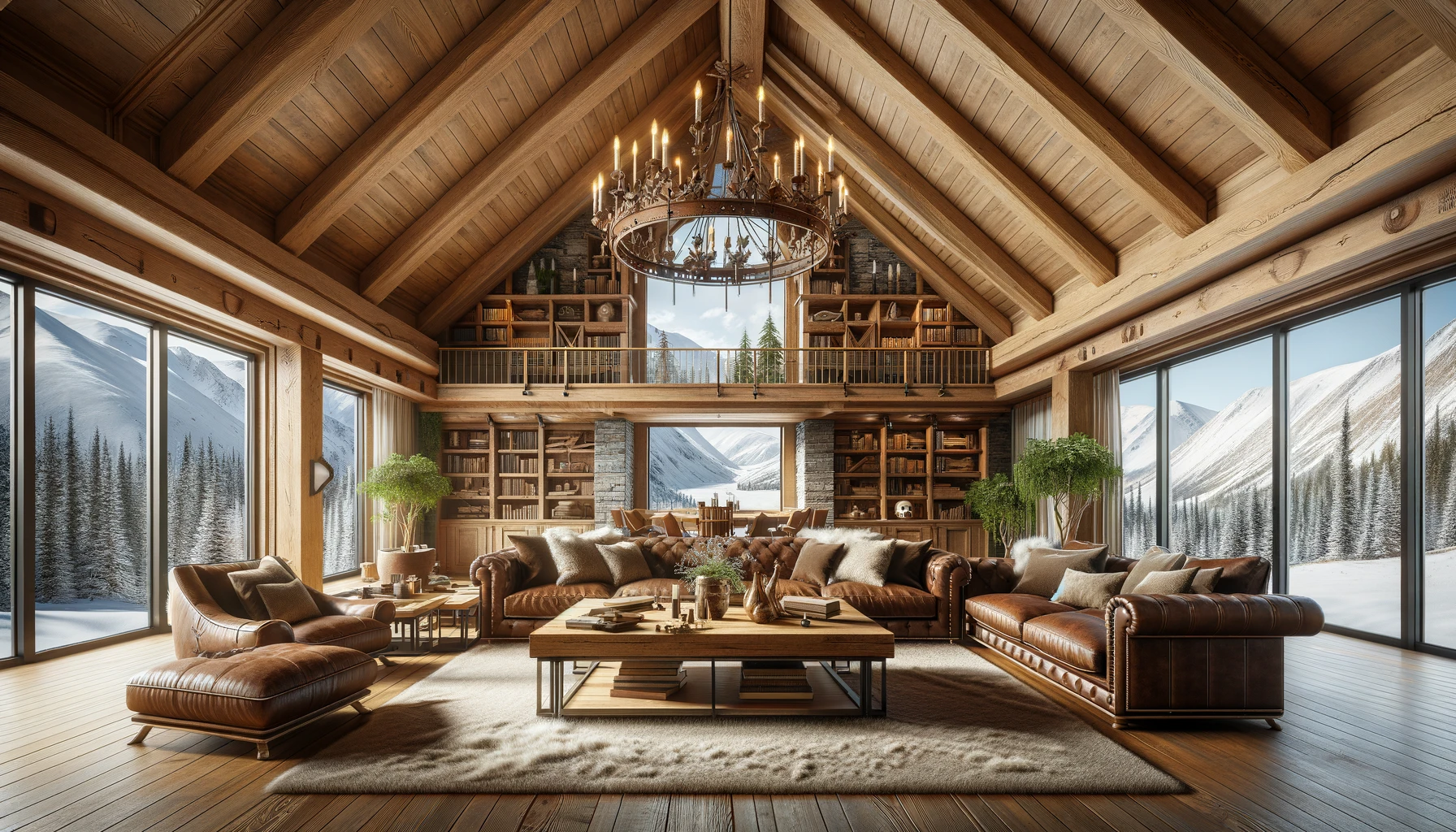
One great place to get started on choosing your office design theme is by putting the various ideas listed above into a Pinterest search, and pinning the styles that resonate with you.
#2 Choose your color palette
Not a genius with color combos? That’s ok. There are color palette generators that make figuring out your color scheme easy!
For your office design, you’ll want to choose one or two main colors that make up 60% of the space, a secondary color that makes up 30% of the space, and an accent color that makes up 10% of the space for a cohesive scheme.
Some classic color palettes include:
- Monochromatic: various shades of the same color
- Analogous: colors made up of hues that neighbor each other on the color wheel
- Triad: colors that make up three colors that form a triangle on the color wheel
- Complementary: colors that are usually opposite each other on the color wheel (example below)
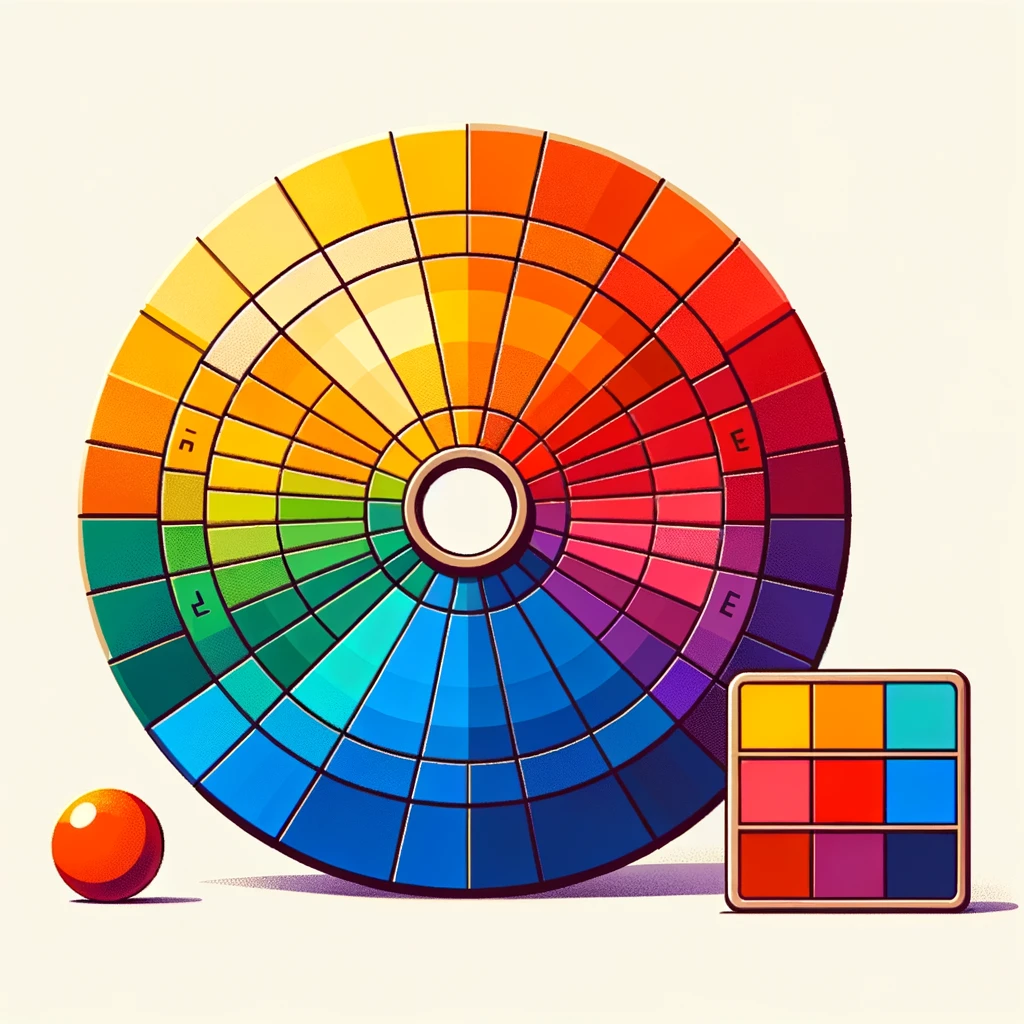
Unfamiliar with color wheels? That’s ok. Canva has a great color wheel tool you can use to figure out which colors go well together!
Pro Tip: Did you know? Colors can affect your behavior! For example, blue can give you a sense of calmness and stability. Check out our article on color psychology to learn more.
#3 Determine a budget that works for you
Determining your budget is not necessarily the fun part of designing your office, but it’s an important step in the process and can free you up to make smart decisions. Remember, you can also try to save with DIY projects or by shopping at second-hand shops.
Here are a few expenses to consider in your budget:
- Remodeling: Flooring, Walls, Labor, etc.
- Furniture: Desk, Chair, Bookshelves, Additional Seating, Tables, etc.
- Lighting: Built-in lights, Lamps, Studio lights, etc.
- Wall and window treatments: Paint, Wallpaper, Curtains, etc.
- Shelving and storage: Built-ins, Bookshelves, etc.
- Accessories: Photos, Plants, Knick-knacks, Supplies, Rugs, etc.
- Art: Posters, Display pieces, Paintings, etc.
#4 Don’t underestimate your DIY capabilities
Looking at a budget may be discouraging, but don’t underestimate what you can build and design yourself! Even if it’s not about the budget, DIY can be fun and a great way to personalize your space. Some office decor you can DIY include:
- Creating a desk with a wood plank and two cabinets
- Painting a wall with chalkboard paint to use as a brainstorming space
- Creating customized items on sites like Zazzle where you can add your own designs to almost any office décor, including wall art, blankets, candles, pillows, lampshades, clocks, rugs, and even door knobs!
#5 Think about how you function
Do you spend a lot of time on Zoom calls? Do you like to start your day with coffee and catching up on the news? When you’re working on projects, do you want to spread things out? Do you have frequent meetings in your office?
Go through the checklist of your typical day, and note the various things you do and the various ways you spend doing them. Note what’s working, not working, and what you can change. This thought process will help you start to determine an ideal layout.
#6 Plan your layout
Planning your layout can start with a simple pen and paper, but you can also use free interior design programs like Room Sketcher to visualize your space virtually.
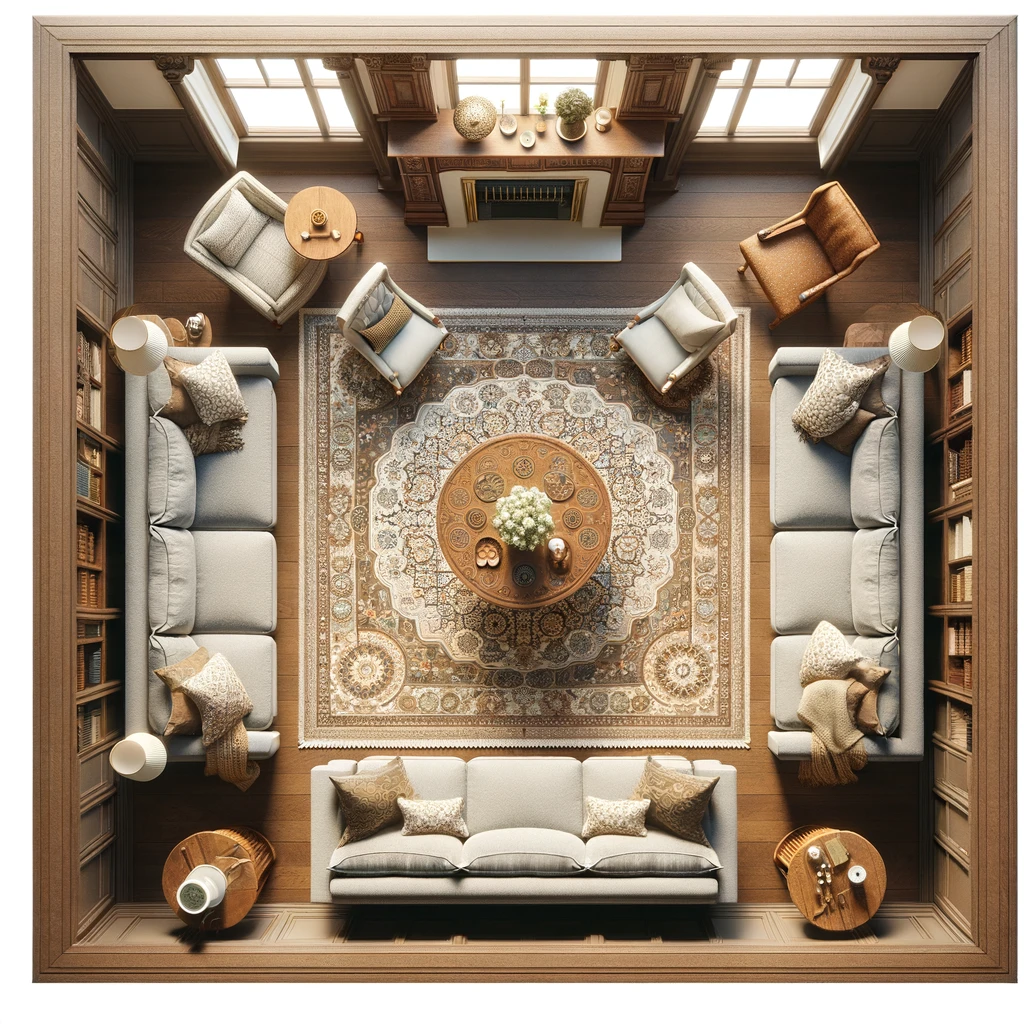
If you’re using paper and pen:
- Draw the walls of your space paper.
- Then draw the different furniture pieces you want to incorporate, and cut them out.
- Then start placing them in the space in different variations.
- Imagine yourself being in the space with your different layouts and pick the one that works best. Remember, you can change your mind later if it doesn’t feel right!
#7 Create office zones
A good layout trick is to create zones for different activities. You can even do this for small spaces with a bit of creativity.
Plan your zones by first figuring out what you plan to do in your office. Then determine what’s most important and where you picture that activity working best in the space. For example:
- In-person meetings: May work best in a space with a few chairs, a small couch, and a table in the middle.
- Zoom calls: May work best in a space with great lighting and a non-distracting background.
- Podcast recordings: May work best in an area divided by sound-absorbing materials.
- Breaks: May work best in a spot designed for inspiration, relaxation, or coffee/snacks.
- Printing: May work best in a space that could be tucked away.
- Reading/Research: May work best in a space away from your desk.
- Writing: May work best at your desk in a quiet area with little distraction.
- Brainstorming: May work best in a larger workspace with inspiration and a large whiteboard or chalkboard.
- Group projects: May work best in a space with a worktable at the center.
Of course, some zones can be dual-purpose, especially in a small space. But this helpful exercise might help you see your space in different ways that bring you the most joy and increase your productivity.
Pro Tip: Don’t underestimate the space in the center of the room. Sometimes there’s an assumption that furniture belongs against the walls, but that leaves dead, unused space in the middle of the room. Maybe it’s time to try putting your desk in the middle!
#8 Add warmth and zoning with rugs
One simple trick to separate the different zones of your office (specifically if you can work with a larger office space) is to add a rug. Not only does a rug help designate specific areas for certain types of activities, but it is also a great way to warm up a room and add character.
Bonus Tip: You can also divide zones and create privacy with wall partitions (see more below in tip #13 on creating privacy).
#9 Show personality with unique flooring
Don’t limit your office design to the walls and décor. If you have the flexibility to change up the flooring to show some character, don’t underestimate how the flooring can show off your personality!
- Hardwood or cement floors: Add a splash of color with paint or rugs.
- Carpet: Add warmth to a room and reduce noise for recordings or frequent video calls. (Attention: be sure the carpet choice works well with your desk chair if you plan to roll around.)
- Laminate flooring: Add unique flooring on a budget!
#10 Let your desk position command the room
Putting your desk in a position that faces the center of the room can make it feel more open while you work and puts you in a command or “power” position to see everything around you.
Additionally, if your desk faces the wall away from your office entry, you may unintentionally be sending a message to others that you aren’t as open to collaboration. Not only that, but you could be setting yourself up to be startled!
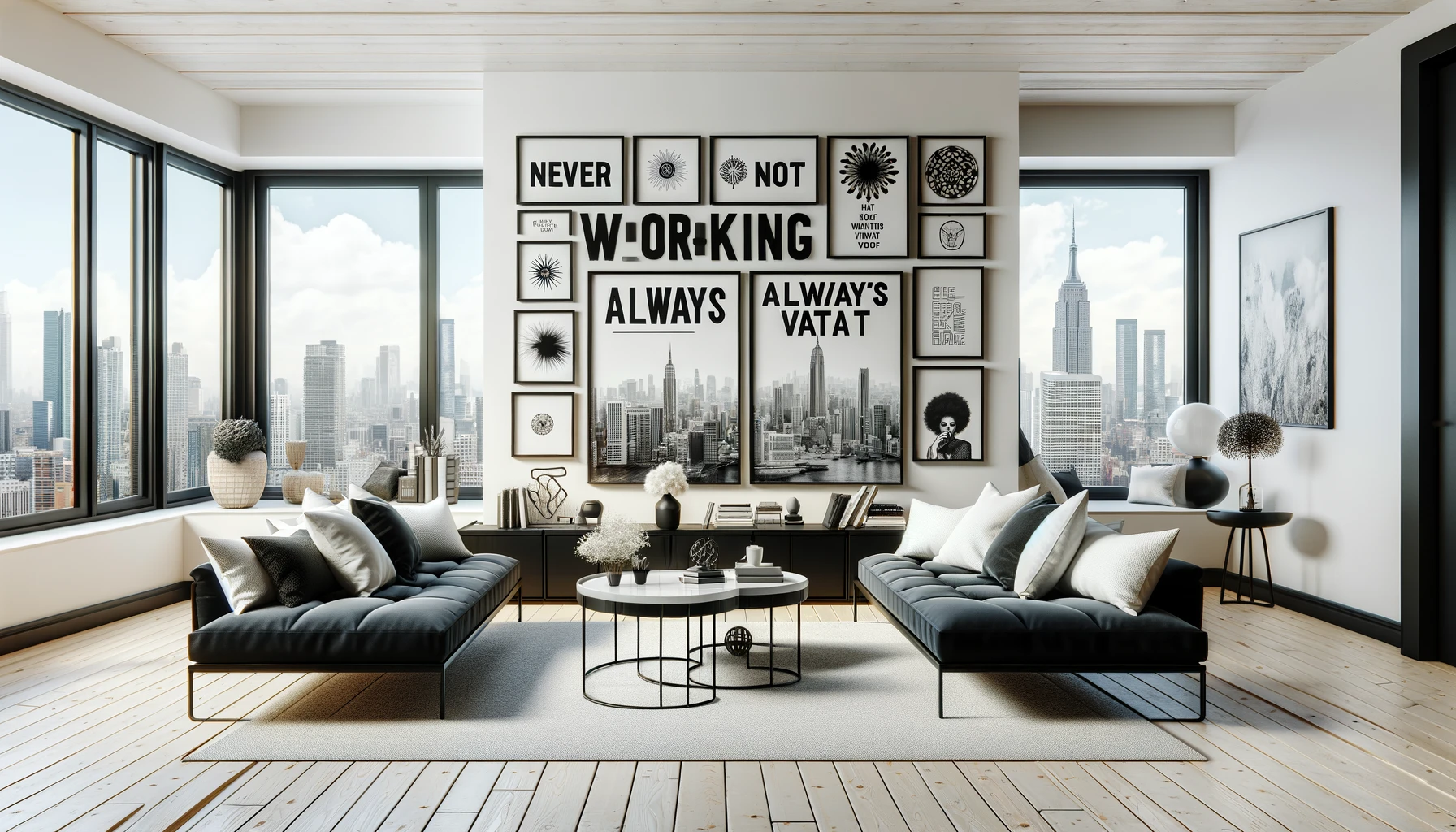
#11 Create a cozy collaborative space
Even if you work alone from home most of the time, having a cozy, collaborative space in your office can make it feel more inviting, especially if you have a roommate or partner who may come in for the occasional conversation. To do this, you can simply add some cozy seating with pillows and throws and a coffee table.
Bonus Tip: This space can also double as your break time space while you sip some coffee and read.
#12 Include privacy features
If your office is a space used for various types of meetings, you may want to add some privacy features that make you feel less exposed. To do this, a straightforward hack is to use decorative wall partitions. This option is also great for home offices, allowing you to separate your office from your living space.
Pro Tip: Your dividers can also be multipurpose! Consider using a double-sided whiteboard or chalkboard/corkboard as a room divider.
#13 Add a fun break space
Giving yourself space for breaks separate from your primary workspace can be a great motivator to get you through the day. Foosball tables, ping pong tables, reading nooks, crafting corners, or music stations are just some options you can try.
#14 Don’t forget about project space
While your desk is a great place to do focused work on your computer, there may be times you need to spread out and look at a lot of different things at once. This is where having ample project space can come in handy. If you don’t have space, multifunctional furniture and storage options might come in handy (see tips #16 and #31).
#15 Create a dynamic group workspace
If you’re in an executive office, lead teams, or have clients visit you, chances are you have various groups of people in your office regularly. As you design your office, consider the hospitality your space can offer with a welcoming space for meetings and discussion.
Features you might include in a group workspace:
- Whiteboard table
- Chalkboard wall
- Accessible outlets
- Comfortable seating
- Accessible snacks and beverages
#16 Opt for multipurpose and multi-functional furniture
If you have a small space, it’s helpful to think of multipurpose uses for your furniture. For example:
- Your project table can double as a large desk
- Your library can double as your communal space
- Your coffee table can fold out and double as an extra desk space
- An office couch can fold out into a bed (if your office also serves as a guestroom)
- A wall can double as a whiteboard or chalkboard wall for brainstorming
- A short bookshelf can double as extra seating (see example below)
#17 Include a fun coffee/beverage station
A coffee and beverage station is a nice feature for offices both large and small, especially if you have teammates or clients visiting. Having a discussion around a cup of coffee can also help break the ice before you get into problem-solving.
#18 Zone your meal space
Having a separate location to eat your meals and take your breaks helps give your brain some breathing room to regroup and come back to work more focused. Your meal space (if it’s not your dining room, kitchen, breakroom, or somewhere offsite) can double as a project workspace.
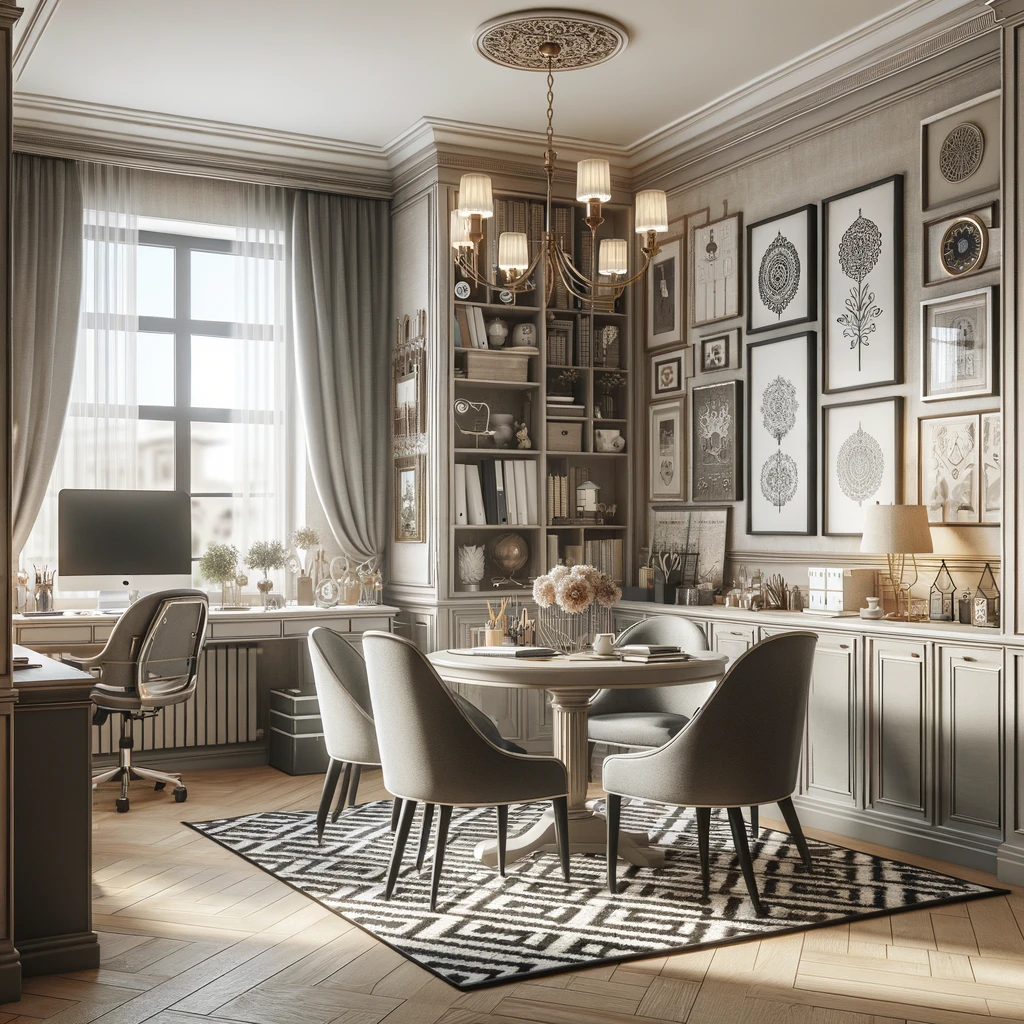
#19 Hide your desk
If you have a home office and you have limited space to work with, building your office into a nook to be tucked away from your personal space might be a great option. This one is designed into a built-in that includes pocket doors that close off the space when it’s not being used.
#20 Create a welcoming entryway
The entryway to your office sets the mood for you and others who enter. To make it welcoming, consider the door design. With windowed doors, you can appear more open. Also, think about door decor and what you see when entering the room.
Does your entry face a gallery wall feature, for example? Or is it time to rearrange your office, so the first thing you see is not a printer and a bunch of wires hanging behind your computer?
#21 Choose cohesive furniture
Your design theme, color palette, and pattern choices can help you determine the best office furniture choices for your space. To make your furniture cohesive, stick to your design theme and the color palette you’ve pre-determined. If a piece of furniture falls outside those guidelines, it will likely look off-balance in your space.
#22 Don’t sacrifice comfort with your office chair
You’re likely to spend a lot of time sitting in your office. It’s important to consider your maximum comfort, not just style, in your budget for your office chair. That’s not to say you sacrifice style, though! There are lots of options that take style, ergonomics, and comfort into consideration.
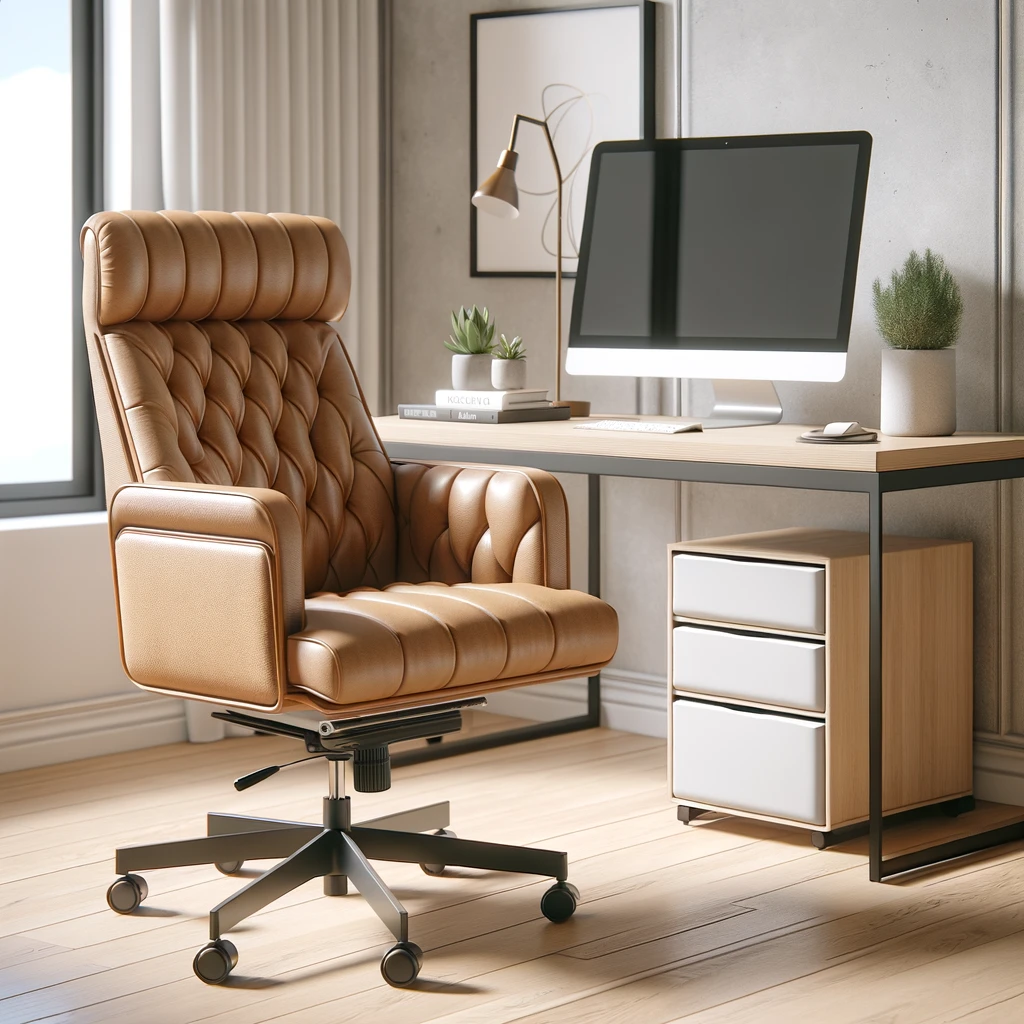
#23 Consider ergonomics with your furniture choices
What is ergonomics? Ergonomics in furniture design considers safety, comfort, and productivity factors. For example, many people opt for standing desks like this one to increase productivity and overall well-being.
#24 Choose comfortable multi-functional furniture
In small office spaces, especially, multi-functional furniture options can be a great space saver, but they don’t have to sacrifice comfort. For example, this couch can serve multiple functions, providing storage and a table when needed.
#25 Create an active office space with smart furniture
One of the benefits of having a standing desk is the option to walk while you work with a treadmill! This is a great way to stay active and get your steps throughout the day. Other active office furniture includes balance ball chairs or even bike desks.
#26 Design around an element or statement piece
If you have a piece of art you love, make it central to your office theme and design around it. For example, if there are colors in your piece of art or if it is from a particular era, pick and choose corresponding colors and elements that match the style of the art or statement piece.
#27 Remove your clutter
To boost productivity and simplify your office space, remove unnecessary items from your desk and office area. To determine whether something is a piece of clutter, pick up each item and ask yourself if having it on your desk or evident in your line of view is distracting, useful/helpful/inspiring.
- If it’s distracting and not useful, get rid of it.
- If it’s a tool or information you use periodically, but don’t use every day, give it a home with accessible storage nearby.
A general rule of thumb is that everything should have a home!
#28 Make your shelving functional and beautiful
Shelving can be not only functional for organizing your books and resources, but it can also be a decorative feature in your office space. Consider using some shelves for books and resources and others for plants and decorative pieces to add character and inspiration.
Additionally, you can even use well-placed bookshelves as room dividers to separate your desk space from your meeting space. (Attention: if you plan to use your bookshelf as a room divider, be sure it is properly secured, so you don’t end up tipping it over!)
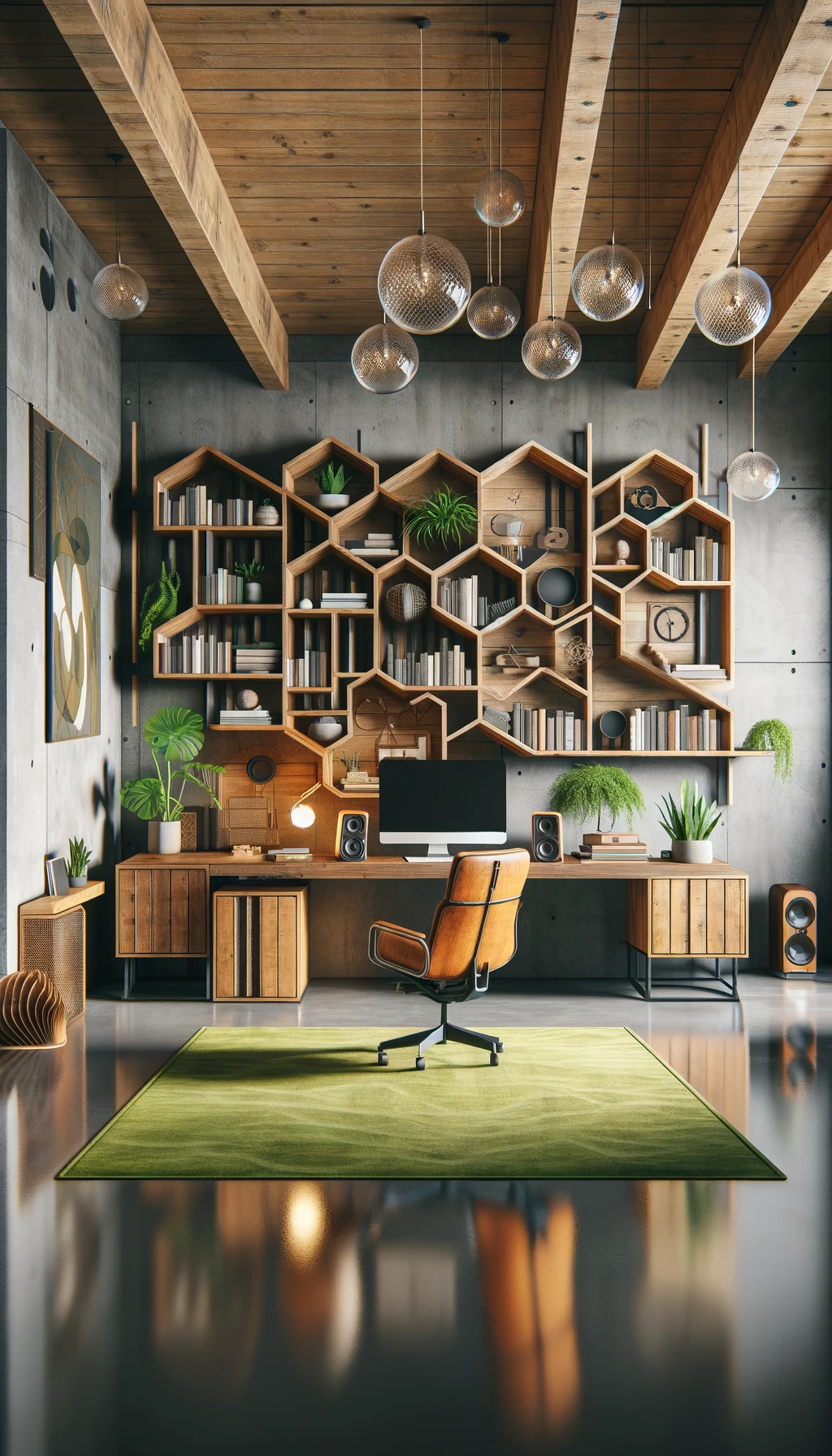
#29 Create your dream library
Offices are a great place to display your library. The bonus is that being surrounded by books can often feel like being surrounded by inspiring friends and brilliant minds while you work!
#30 Hide ugly office equipment
With smart and well-designed storage, you can hide away office equipment like printers and scanners in built-ins or shelving that allows them to be easily accessible, but outside of view.
#31 Get creative with storage
If you’re working with a small space, get creative with your storage options. For example, this shelving unit from Ikea includes a foldout table you can use for projects. Then when you’re done, you can fold it back up and out of your way!
#32 Add unique built-ins for smart function and privacy
Built-ins offer a creative alternative to bookshelves and can elevate an office space’s professional feel. They can be beneficial if you need to hide away sensitive information and files that you would rather not keep out in the open.
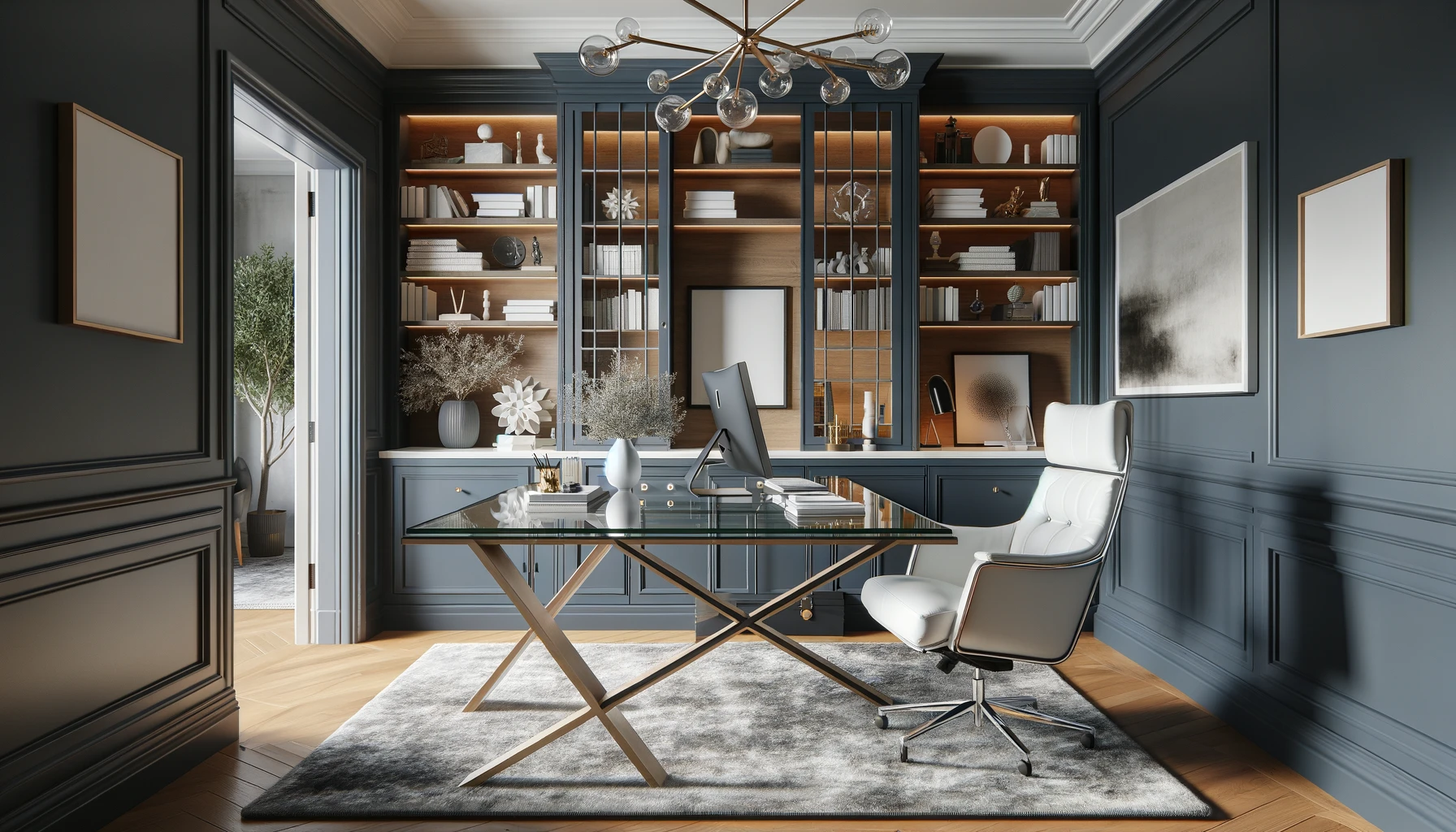
#33 Get organized for peace of mind
There’s more to creating a productive office space than beautiful decorations. Consider clever organization ideas to help you stay on task without getting lost. Some features to consider include:
- Inbox/outbox system: to file incoming items and things to be delivered
- Entryway shelf: to place your keys, mail, or items needed as you come in and out
- Draw organizer: to give your office supplies a home including pens, stapler, etc.
- Display calendar: to remind you what you have coming up this week
- Displayed to-do list: to remind you of your most important goals and tasks
- Labels: to help give all supplies a designated home and avoid clutter
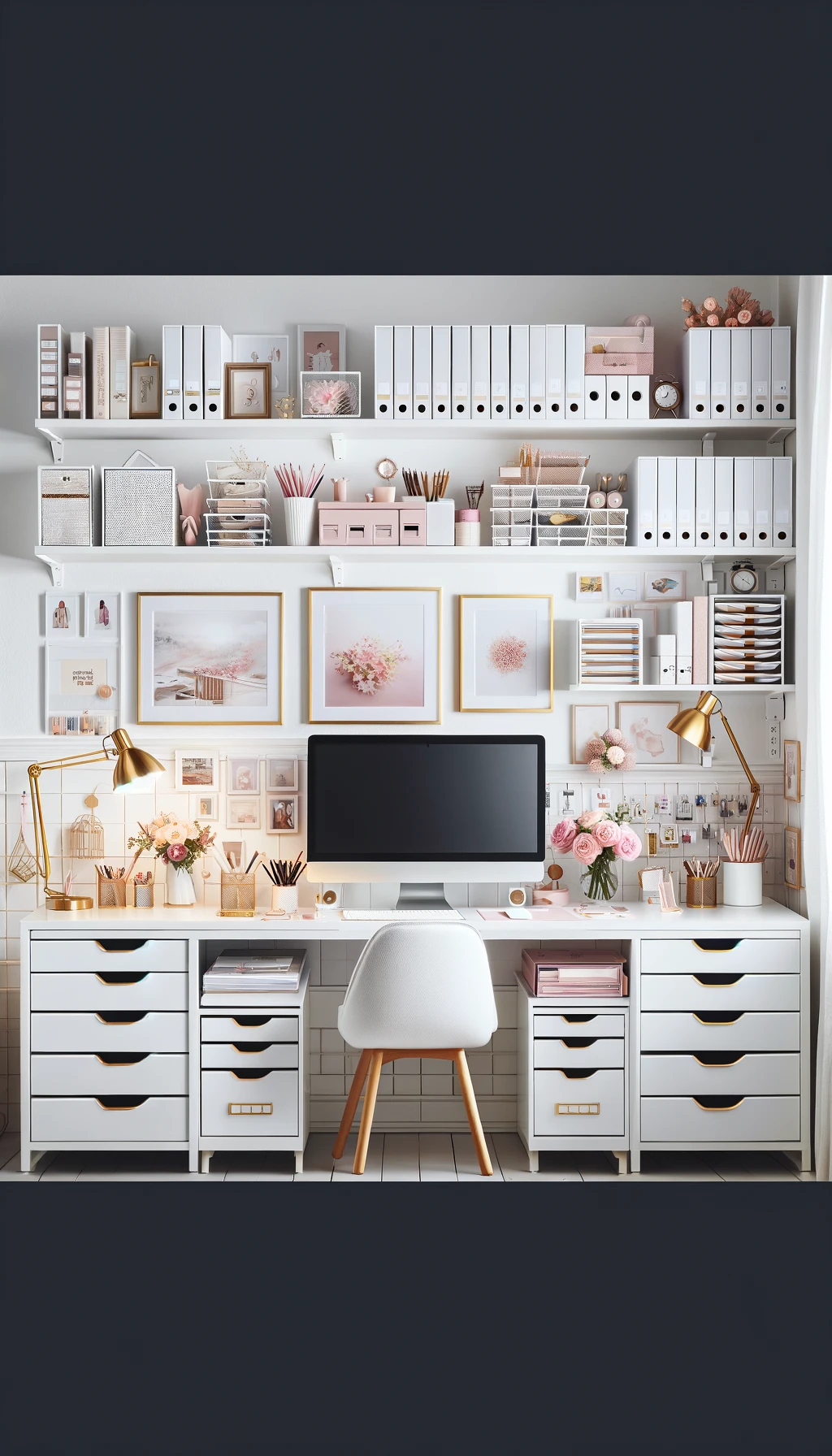
#34 Include plants for smart accents
Not only do plants give your office space color accents, but it also turns out they are good for you too. According to research1https://greenplantsforgreenbuildings.org/wp-content/uploads/2015/08/Human-Spaces-Report-Biophilic-Global_Impact_Biophilic_Design.pdf, having plants in your office can boost productivity by 15%!
#35 Incorporate flowers for added joy
Being around nature reduces stress4https://www.health.harvard.edu/mind-and-mood/a-20-minute-nature-break-relieves-stress and can boost creativity5https://www.forbes.com/sites/alankohll/2019/01/24/how-your-office-space-impacts-employee-wellbeing/?sh=6c53810564f3. By including flowers in your office space, you bring a little of that nature inside!
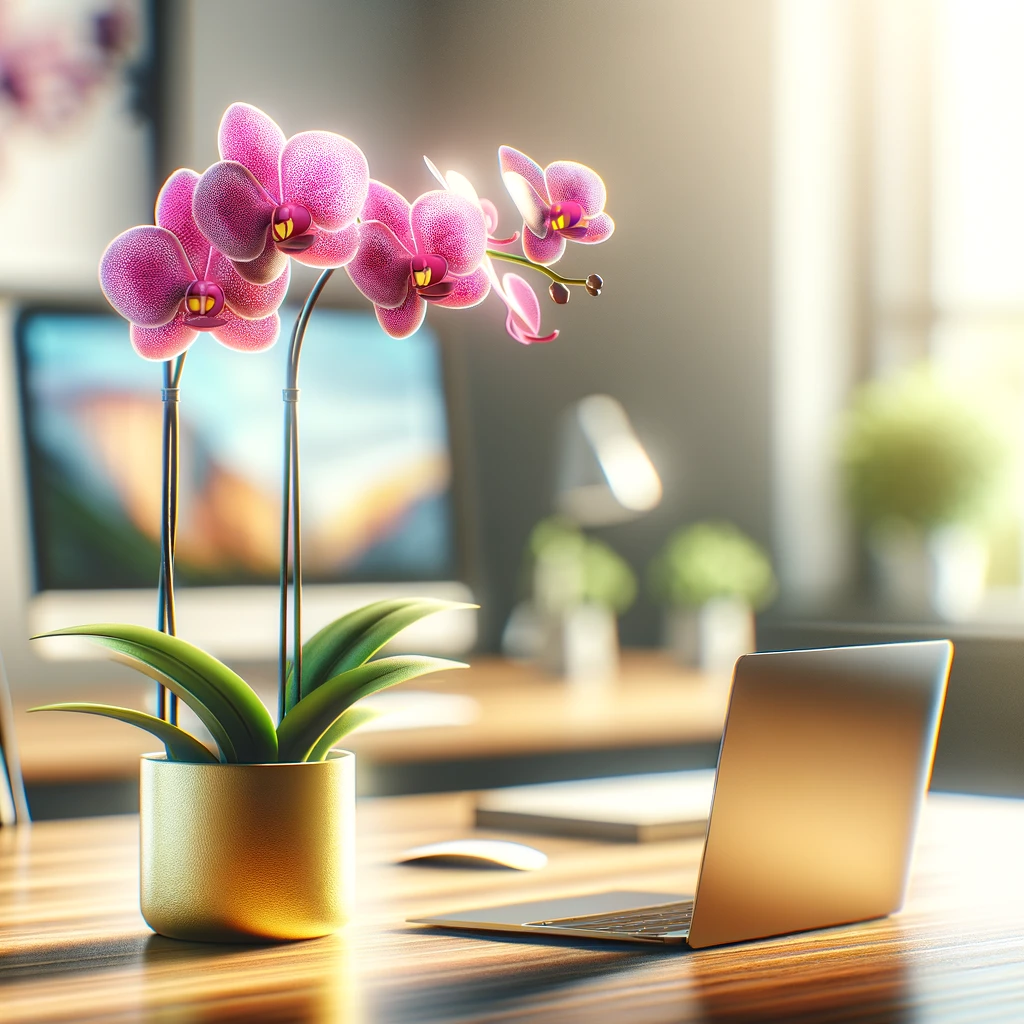
#36 Light your room with the right energy
Light can impact the mood of your room in a significant way. In fact, warm and cold light can influence your productivity differently. For example, research shows6https://onlinemba.unc.edu/news/how-lighting-affects-productivity/ that warm light (like a sunset) can make you feel more relaxed, while cold light (like an overcast day) can boost alertness. Depending on your activity, you should include different kinds of lighting. And don’t forget about the benefits of natural light, including vitamin D, which helps you focus (see more in tip #37).
#37 Incorporate natural light
Incorporating natural light in your office space design is a smart move! The many benefits7https://sustainability.ncsu.edu/blog/changeyourstate/benefits-of-natural-light/ of exposure to natural light include stress reduction, better sleep, elevated mood, reduced stress, and deeper focus. Choose soft curtains that bring in more light or mirrors that can bounce more natural light around the room.
Pro Tip: If you have limited access to natural light in your office, you can use alternatives like a daylight lamp, which simulate sunlight and help boost your mood.
#38 Incorporate outside views into your design layout
Being around nature4https://www.health.harvard.edu/mind-and-mood/a-20-minute-nature-break-relieves-stress is known to boost your mood, increase focus, and reduce stress. So if you can, place your desk in a direction that faces toward the natural environment rather than a wall. If you don’t have a view from your office that’s worth looking at, you can make up for it by incorporating more plants and images of nature instead.
#39 Remember, acoustics and noise matter too
When you design your office, you may forget about the acoustics. It’s not usually top of mind when thinking about design. But it shouldn’t be ignored. The acoustics of your office space can make or break your focus. Hard surfaces like wood floors and high ceilings can impact the acoustics in your office and create an echo.
To reduce the noise, consider noise-absorbing materials like rugs, curtains, and noise-reduction wall tiles (below). Considering the acoustics in your office is especially important if you plan to have private conversations (if you’re a counselor, for example), if you plan to be on frequent video calls, or if you plan to do podcast recordings.
#40 Set the mood with inspiring and calming scents
Another common element of a good office design that people often forget about is the scent. Did you know? Scent8https://www.ncbi.nlm.nih.gov/pmc/articles/PMC1905909/ can trigger an emotional response and is closely linked to memory9https://news.harvard.edu/gazette/story/2020/02/how-scent-emotion-and-memory-are-intertwined-and-exploited/. Research10https://www.frontiersin.org/articles/10.3389/fnbeh.2020.00035/full also shows that scent is also known to boost your mood and relax you. For example, lavender can be a very calming and relaxing scent.
Try including an aromatherapy oil diffuser like this to increase your office mood. (You can also go for candles if you’re allowed, but many corporate offices do not allow candles for safety reasons.)
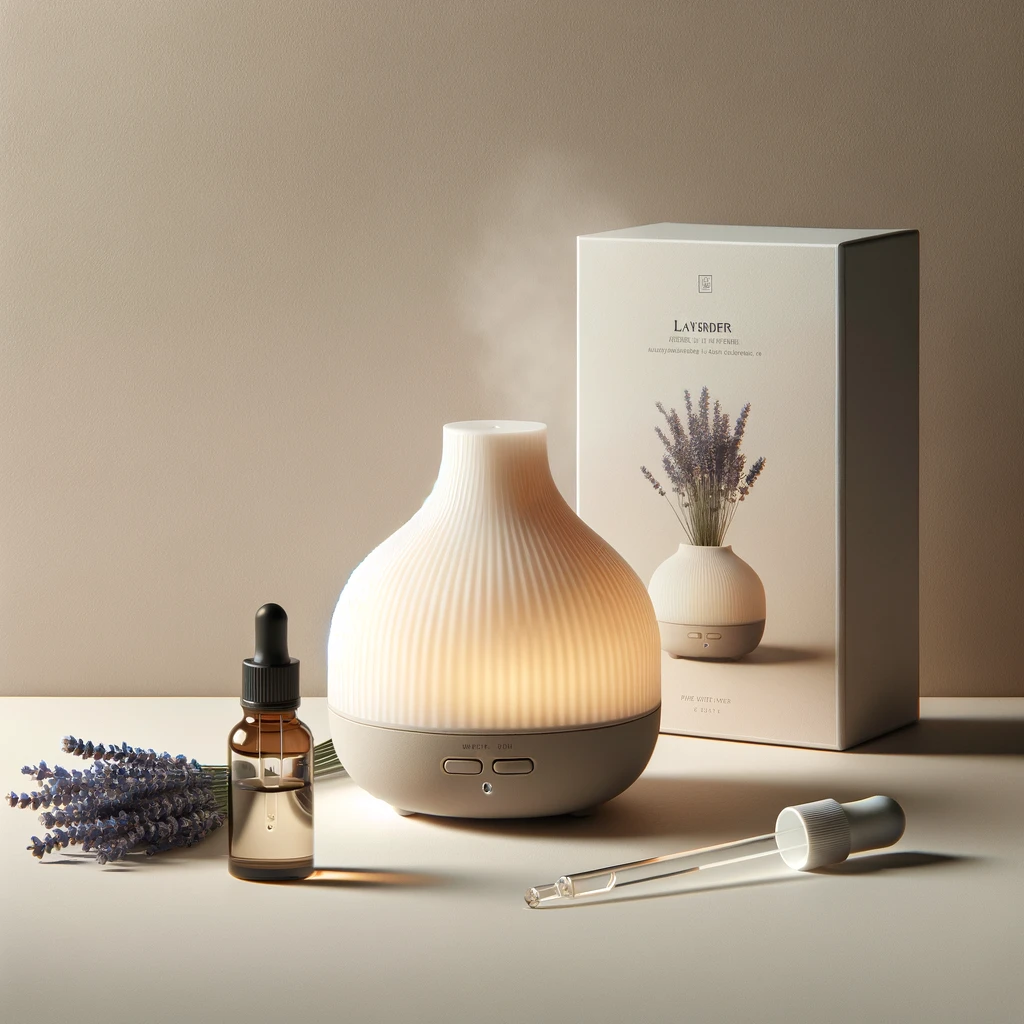
#41 Keep healthy snacks in classy containers
Having healthy snacks on hand in your office can keep you from going after a quick sugar fix. Snacks are also a great way to boost the hospitality factor of your office, especially if you have clients and teammates visiting your office frequently. Add your snacks to decorative containers to elevate the classiness of your snack selection!
#42 Hide your wires
A common conundrum you’ll deal with in your office design is what to do about all those wires. They’re rarely ever pretty, but they’re always necessary. Fortunately, there are some smart solutions out there that utilize functional, classy designs to hide those pesky wires, including this one found on Etsy.
#43 Opt for non-boring trash cans
Trash cans are a necessity, but they don’t have to be boring. Choose a trash can that is cohesive with your overall design!
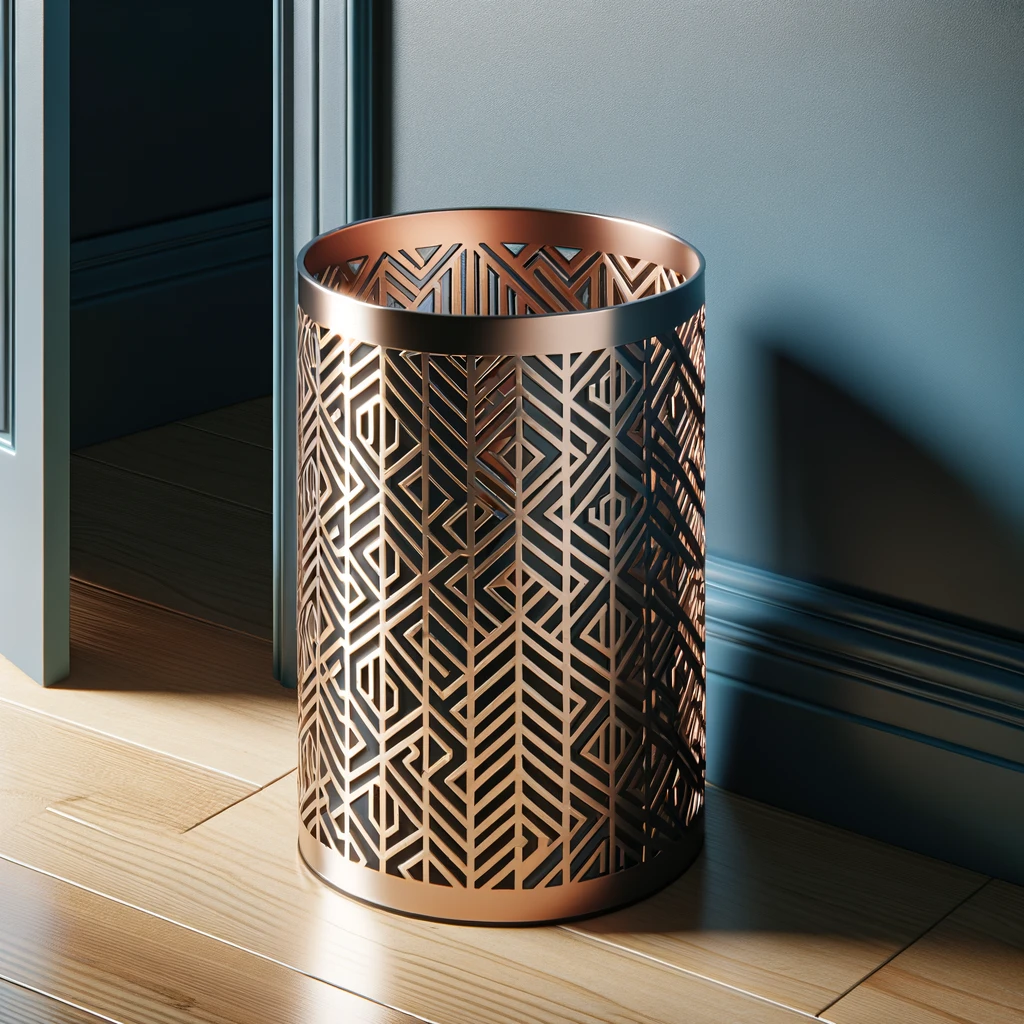
#44 Choose statement pieces for conversation starters
Icebreakers are a great way to start a meeting or conversation with a colleague. By incorporating a statement piece into your office design, especially one that is centered around something you love, you create a built-in icebreaker people can naturally ask you about.
To choose your statement piece, consider your hobbies, likes, passions, etc. Find a piece of art or an artifact that represents it and incorporate it into your design.
# 45 Incorporate accents with color or decor
10% of your color palette should include an accent color. Use this color as a splash to put around your office. Incorporate the color in art, pillows, plants, throw blankets, a vase, etc.
#46 Utilize art to boost creativity
Art is a great creativity booster. Sometimes when you’re in a rut in your thinking process, exposing yourself to art that inspires you can elevate your creativity. Be sure to choose art based on things that boost your mood or get you thinking, and stay away from art that brings you down.
#47 Add an accent wall
Adding an accent wall can make your office space look bigger than it actually is. When choosing which wall you want to accent, consider that this wall is usually considered the focal point or the area of the room you want people’s eyes to be drawn to.
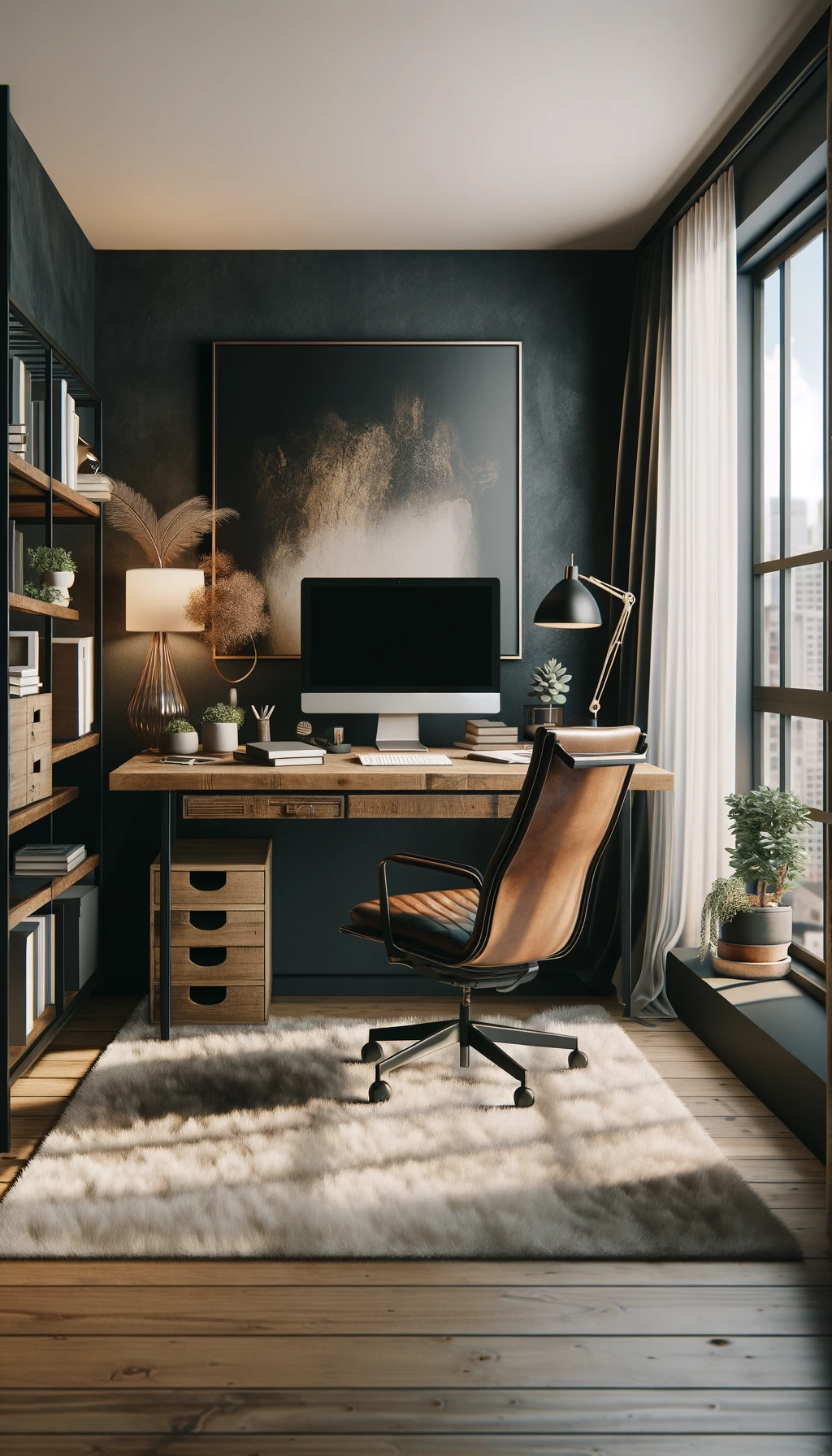
#48 Incorporate cohesive accessories
Choose accessories that match and are cohesive to the rest of your office design. Since office supplies are often smaller items, perhaps you choose to get your accessories in your chosen accent color.
#49 Add a unique statement calendar
Calendars are essential pieces in most offices and help aid in goal setting and task management, but they don’t have to be boring! In this office space, this designer used an acrylic wall-mounted calendar she can write on with a dry-erase marker. And it looks classy!
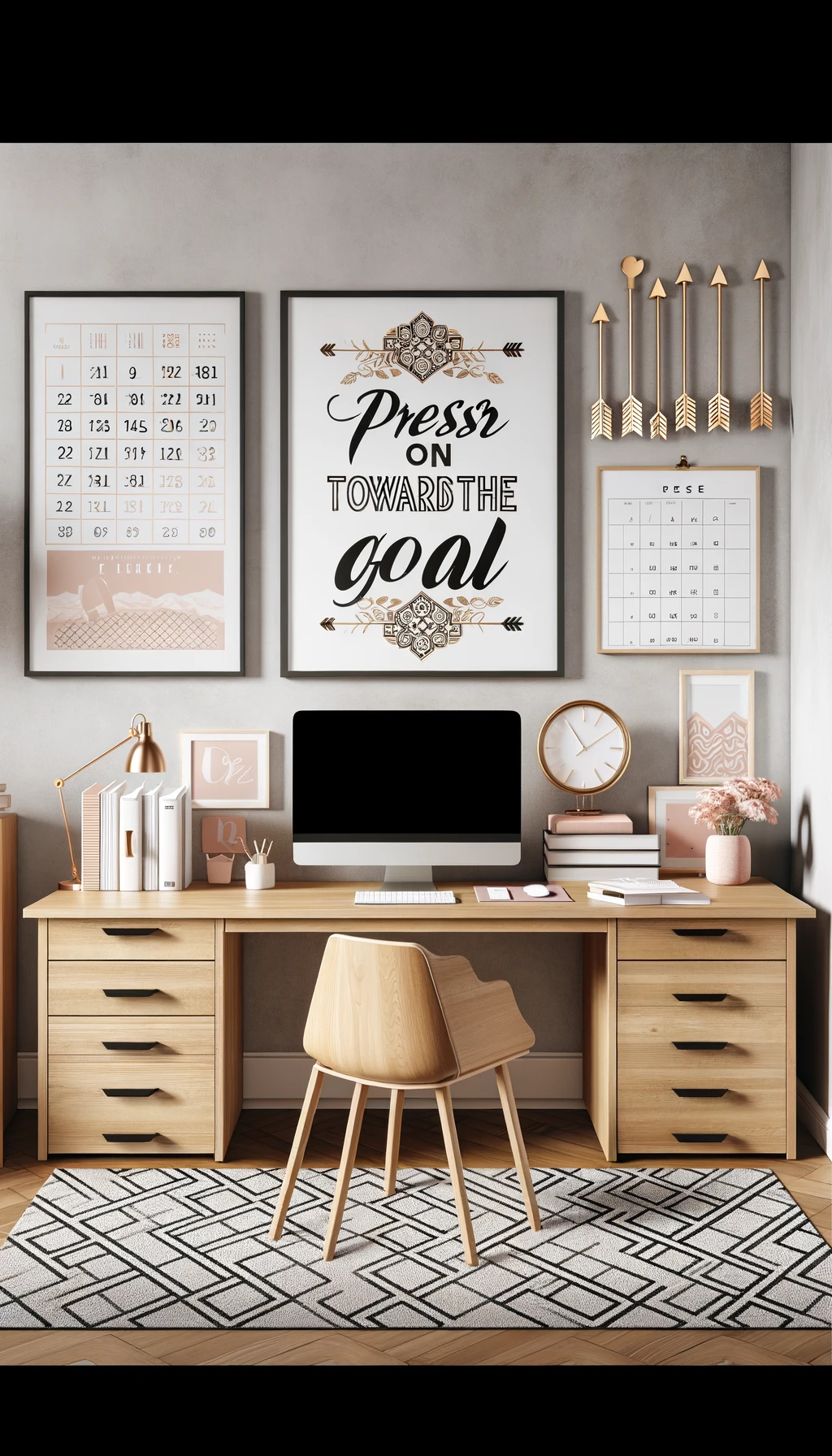
#50 Incorporate inspiring goal and task-tracking decor
To track your progress and tasks, you can utilize creative décor options like a magnetic chalkboard wall, an acrylic-mounted board, cork wall, or whiteboard wall. Some tables allow you to draw on them with chalk or dry-erase markers.
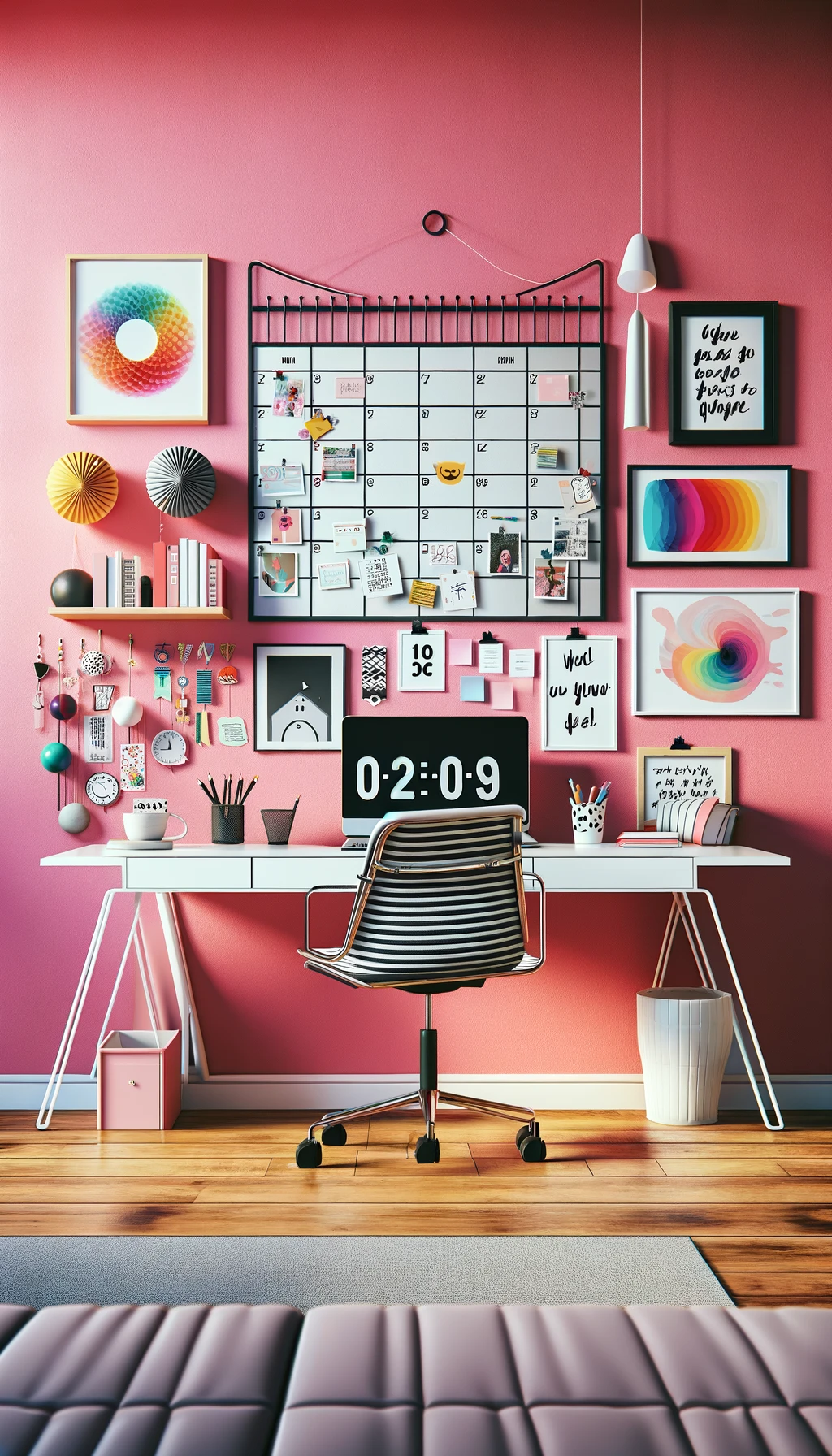
#51 Include a workspace wall
If you enjoy brainstorming on big spaces that you can look at throughout the day, a workspace wall may be an excellent choice for you.
#52 Incorporate decor that inspires you (like a gallery wall)
Like having art that boosts creativity, a gallery wall of inspiration is a great way to stay motivated. However, in this instance, your art or decor would incorporate things specific to your work, like quotes from industry-relevant thought leaders or inspiration from your heroes.
For example, maybe there’s a song with lyrics that gets you going. Perhaps there’s an image, word, or artifact from the music that can be displayed in your office.
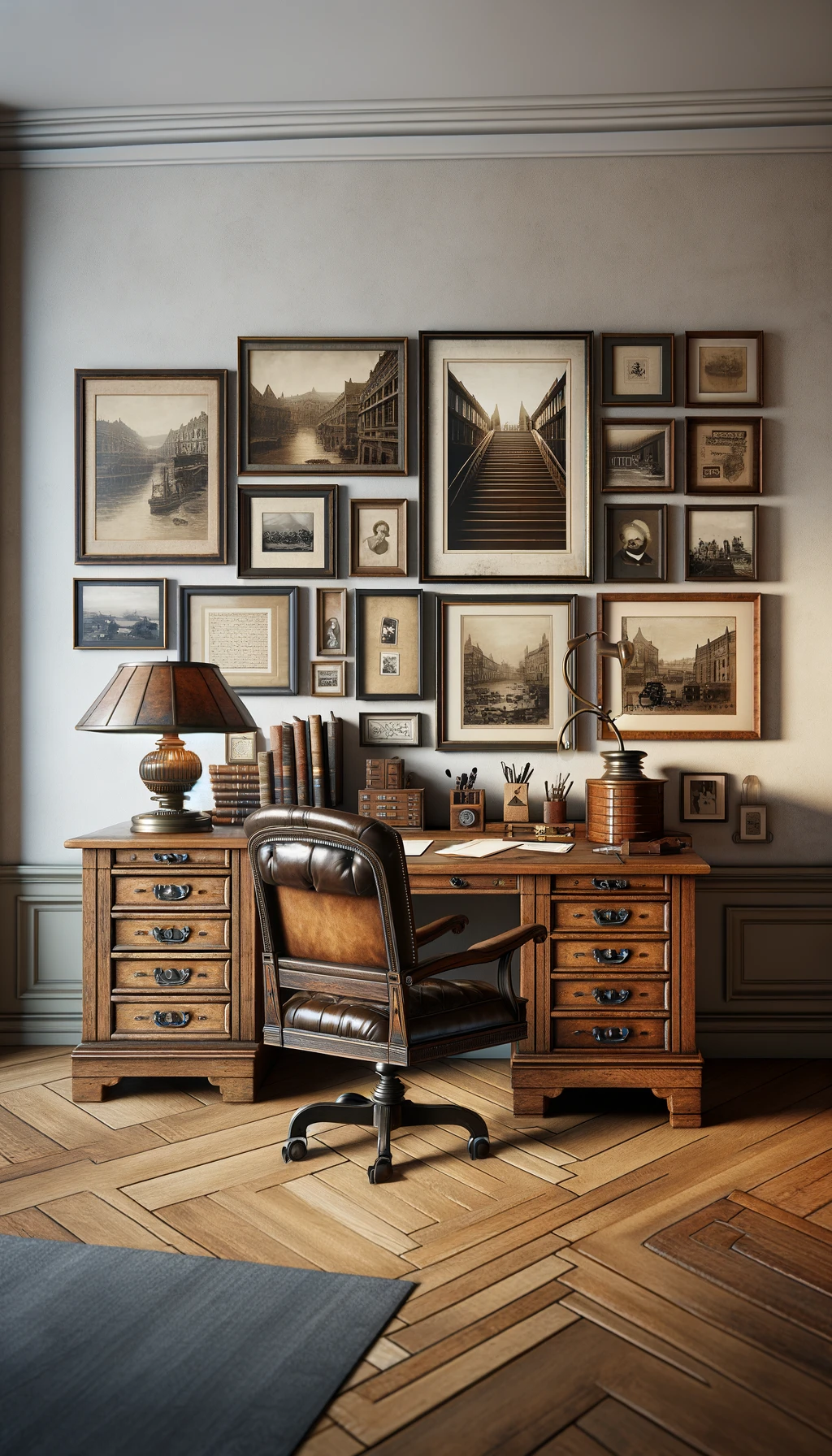
#53 Display your vision boards
Vision boards help you visualize your goals and dreams in an inspiring and creativity. Your office is the perfect place to display your vision board because you likely spend a good amount of your time there.
#54 Display your company mission
Whether you work from a corporate office or from home for yourself, displaying your company mission and vision can help remind you why you do what you do every day.
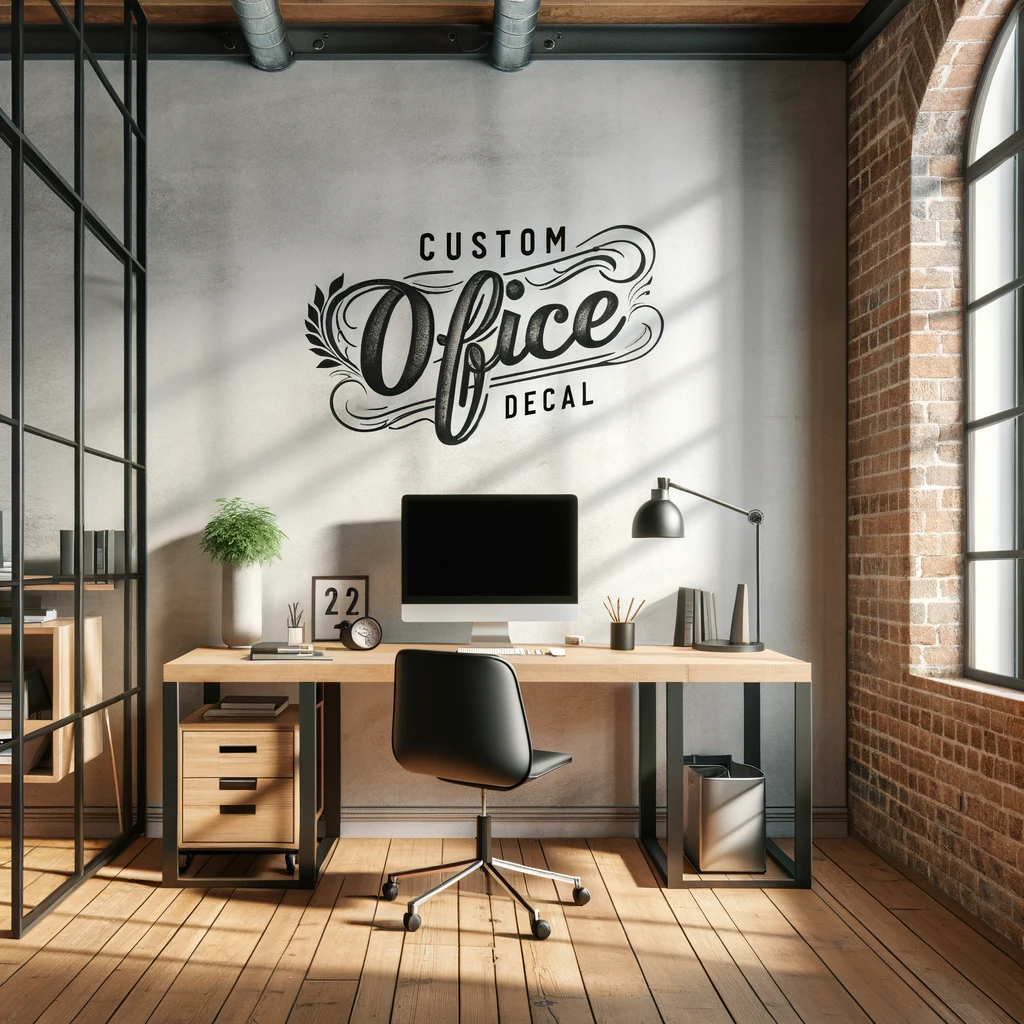
#55 Incorporate customer photos and stories
Displaying your company’s vision and mission is motivating, but including customer photos and stories is frosting on the cake to keep you motivated and remind you why you do what you do, and who you do it for.
#56 Include non-image wall and shelf decor
Not all of your wall décor needs to be image-based. Be sure to mix it up with other elements like plants, vases, word art, statues, globes, and other features that inspire you.
#57 Spice it up with personalization
Pictures of your family, friends, colleagues, travel explorations, and milestones (personal and work-related) is a great way to add some personalization to your office space and create conversation starters with others.
#58 Choose decorative elements and images that motivate
What boosts your mood and keeps you motivated? To help you think through how you can decorate with motivational items, ask yourself, “What elements, images, or words come to mind as I think of each of these things?”
- Favorite places
- Favorite quotes
- Favorite songs
- Favorite ideas
- Favorite thought leaders
- Favorite authors
- Favorite movies
- Favorite people
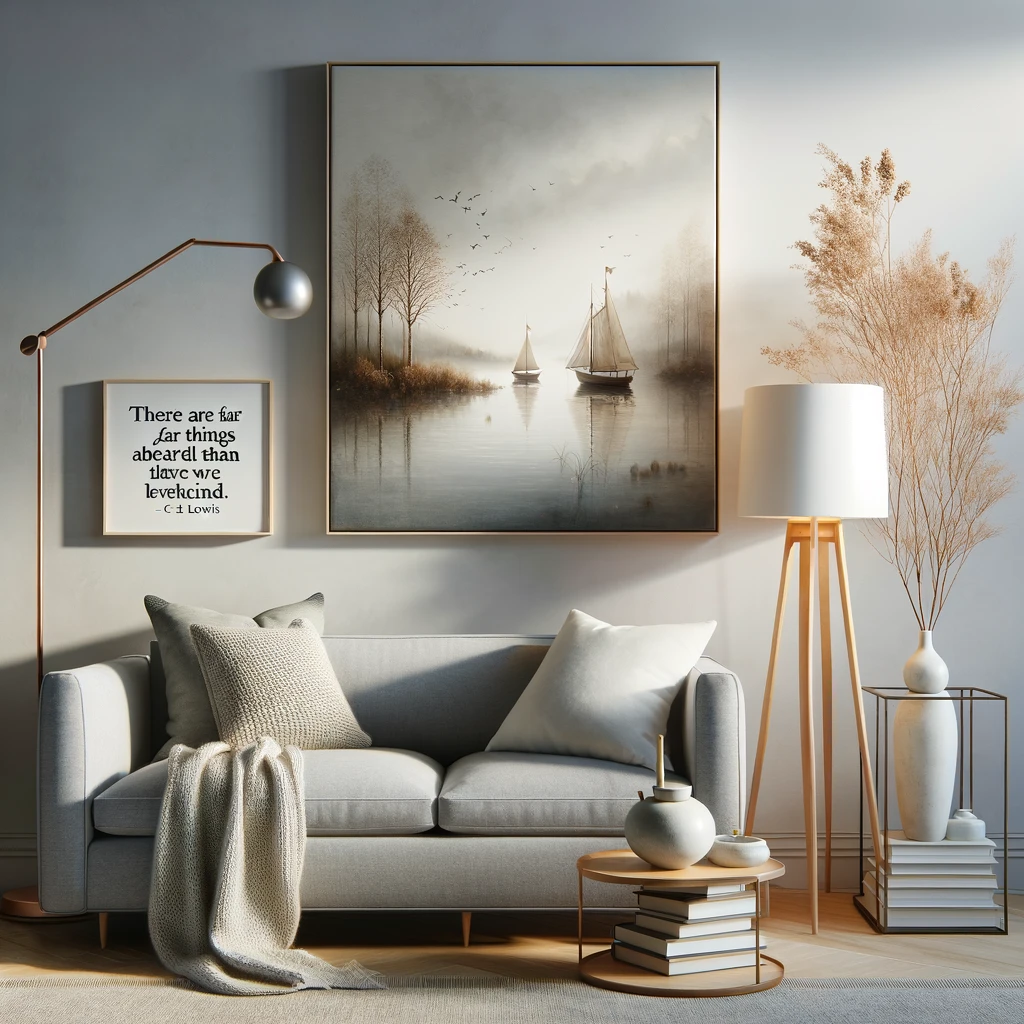
#59 Incorporate pattern
Adding a pattern to your office is a fun way to add accents and character to your space. Be careful not to overdo it with patterns, as it can start to look busy and distracting.
#60 Use mirrors to make a space feel larger
One interior design trick to give the illusion of a larger space is to add a mirror. Another benefit of a mirror is boosting the light exposure around the room.
#61 Don’t forget about your computer desktop image
When your computer desktop is asleep, what do you see? Is it inspiring? Don’t forget about this piece of the puzzle. Choose a desktop image that inspires you (or is functional, like a clock). And when your computer is asleep, consider an image that is cohesive to the rest of your décor.
#62 Choose non-cheesy seasonal decor
Around the holidays, people often like to dress up their offices for the season. There are ways to keep it classy without your office looking like a kindergarten classroom. Consider shopping at places like Homegoods or Overstock for classy seasonal décor. For example, here is some classy fall seasonal décor for an office!
#63 Build an outside office shed space
If you have the budget and space for it, you might try opting to build your home office space detached from your house altogether! This is a fun option if you want to be in nature, need some extra privacy, or desire to separate your home from your work.
#64 Remember the pets
If you work from home, you might have a furry coworker who likes to join you. As you design your new space, think about them too. For example, you can create a built-in cubby for them!
#65 Transform the closet
In a home office with limited space, you can opt to build your office into a closet. Searching on Pinterest for closet offices or “cloffice,” you can find several creative ideas like this:
What’s the best way to decorate a small office space?
The best way to decorate and design for a small office space is to use multi-functional furniture pieces that can be used for multiple purposes. For example, a shelf that folds out into a project table or a bookshelf that also serves as a bench.
While you may not be able to have a large layout with multiple zones, focus on a cohesive color scheme and consider an accent wall and a mirror to make the office appear larger.
What’s the best way to decorate a large office space?
The best way to decorate and design a large office space is to create zones for various activities, including collaboration, meetings, breaks, projects, and focused work. Separate zones with creative flooring and rugs. Add privacy with decorative dividing walls that can double as a project workspace.
Office Decor Takeaways
In summary, take note of these tips as you start to decorate your office:
- Theme: Choose a theme that resonates with your personality and focuses on decisions.
- Colors: Choose a color palette that boosts creativity.
- Nature: Incorporate elements of nature to boost productivity.
- Organization: Use smart, functional furniture and accessories to reduce stress.
- Comfort: Consider ergonomics in your furniture choices and layout.
- Light: Consider warm and cool light for various contexts, and incorporate natural light as much as possible.
- Acoustics: Remember to include pieces to absorb sound and reduce noise.
- Smells: Remember, even the scent of your room can reduce stress.
For more ideas to find happiness at work, check out our article, How to Do What You Love: Use Science to Be Happy at Work.
Article sources
- https://greenplantsforgreenbuildings.org/wp-content/uploads/2015/08/Human-Spaces-Report-Biophilic-Global_Impact_Biophilic_Design.pdf
- https://www.nytimes.com/2019/01/03/well/mind/clutter-stress-procrastination-psychology.html
- https://www.researchgate.net/publication/343711872_Effect_of_workstation_configuration_on_musculoskeletal_discomfort_productivity_postural_risks_and_perceived_fatigue_in_a_sit-stand-walk_intervention_for_computer-based_work
- https://www.health.harvard.edu/mind-and-mood/a-20-minute-nature-break-relieves-stress
- https://www.forbes.com/sites/alankohll/2019/01/24/how-your-office-space-impacts-employee-wellbeing/?sh=6c53810564f3
- https://onlinemba.unc.edu/news/how-lighting-affects-productivity/
- https://sustainability.ncsu.edu/blog/changeyourstate/benefits-of-natural-light/
- https://www.ncbi.nlm.nih.gov/pmc/articles/PMC1905909/
- https://news.harvard.edu/gazette/story/2020/02/how-scent-emotion-and-memory-are-intertwined-and-exploited/
- https://www.frontiersin.org/articles/10.3389/fnbeh.2020.00035/full
How to Deal with Difficult People at Work
Do you have a difficult boss? Colleague? Client? Learn how to transform your difficult relationship.
I’ll show you my science-based approach to building a strong, productive relationship with even the most difficult people.
